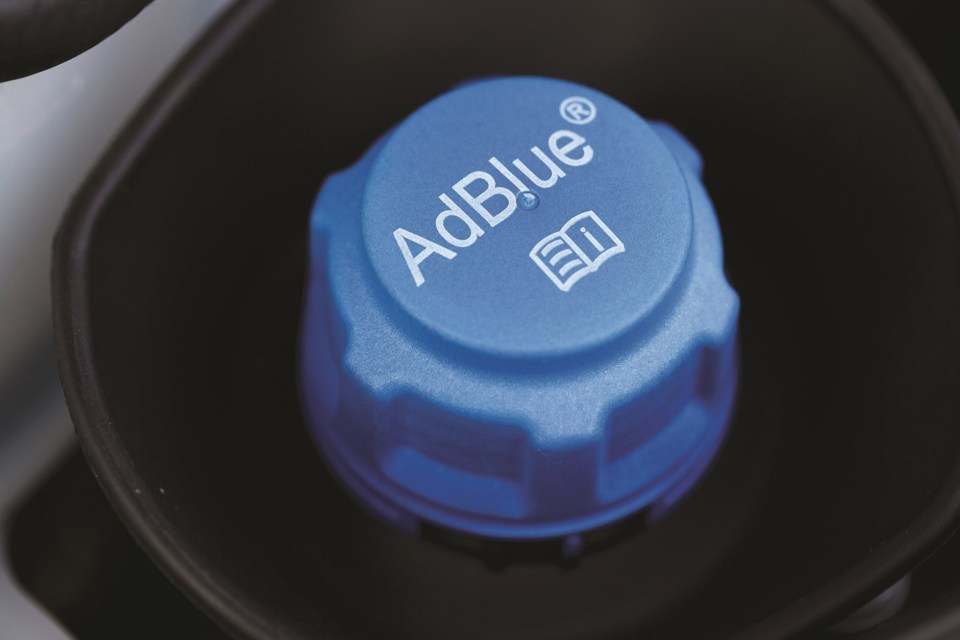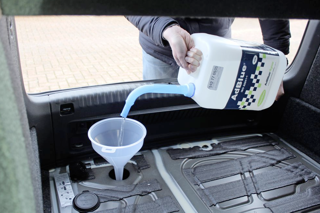Driver ignorance is behind the majority of 23,000-plus breakdowns linked to AdBlue last year, almost twice the total for the previous 12 months, reports the AA.
The roadside breakdown and recovery company also attended at least one driver who filled their diesel tank with AdBlue.
Many diesel cars built after 2015 are equipped with a Selective Catalytic Reduction (SCR) system, which uses a liquid solution of urea, called AdBlue, (also known as Diesel Exhaust Fluid or DE). This causes a chemical reaction in the exhaust system that converts harmful nitrogen oxides into harmless water and nitrogen, significantly cleaning up tailpipe emissions.
Cars with this technology have a separate filler for an AdBlue tank, often next to the diesel fuel filler or in the boot or under the bonnet.
The solution is injected automatically in small quantities into the flow of exhaust gas and should not be poured into the fuel tank.
AA president Edmund King said: “Our recovery service is seeing a rapid growth in breakdowns due to accidental misuse or lack of understanding of the need for AdBlue.
“If it’s poured into the fuel tank it can cause expensive damage if the engine is allowed to run.
“Many drivers call for help because they can’t start their car simply because the AdBlue tank has run dry. That comes as quite a shock to many AA Members, particularly those who don’t regularly drive a diesel car but may be in a hire or fleet car and have no idea what it is or does.”
The product is usually sold in bottles at forecourts although some have started to install separate pumps.
Most diesel drivers will need to top up the AdBlue at least once between services, so it is important to keep an eye on dashboard warnings, particularly for high mileage drivers.
King continued: “Although the dashboard will give plenty of warning that the AdBlue tank needs replenishing, many drivers don’t understand what the warning means and ignore it. Our message is keep your tank topped up to avoid the AdBlue blues.”
What is AdBlue?
AdBlue is a trade name registered by the German car manufacturers association, but is the most recognised form of Diesel Exhaust Fluid (DEF).
AdBlue is not actually blue at all, but is a colourless, non-toxic mixture of urea and de-ionised water.
It’s an exhaust fluid – not a fuel additive – and is stored in a separate reservoir topped up via a (usually) blue filler cap located either next to the fuel filler, in the boot or under the bonnet.
What happens if you put AdBlue in the diesel?
AdBlue isn’t a fuel additive and putting it directly into the fuel tank could cause expensive damage to the fuel pump and injection system.
If the mistake is realised before the engine is started, the tank will require flushing out and refilling with diesel in the same way as if petrol had accidentally been put in the tank. But If the engine is started it could become an expensive write-off.
How does AdBlue work?
Tiny amounts of AdBlue are injected into the flow of exhaust gasses. At high temperatures AdBlue turns into ammonia and carbon dioxide and acts as a catalyst to convert harmful nitrogen oxides to harmless nitrogen and water.
Similar technology has been used effectively for years in buses, heavy trucks and diesel trains.
Increasing numbers of manufacturers are using AdBlue technology. Diesels made by Jaguar, Land Rover or any French or German makers, and registered new after September 2015, are likely to use AdBlue.
What happens if your car runs out of AdBlue?
If you run out of AdBlue while you’re driving, then the engine’s power and performance will be reduced to ‘limp home’ mode to limit its emissions and once the engine has stopped, it won’t re-start until the AdBlue tank is refilled.
The car’s dashboard will provide plenty of warning that the AdBlue tank’s running low – usually with around 1500 miles supply remaining followed by an amber warning light when the tank is nearly empty.
The rate at which cars use AdBlue varies depending on the engine and how the car is driven.
Typical consumption seems to be around a litre of AdBlue every 600 miles but could be as high as a litre every 350 miles.
The size of the tank varies too so the range between refills could be somewhere between 3,000 and 12,000 miles depending on the car and driving style.























Alan D - 26/06/2018 11:55
Urea ? Does that mean in an emergency, you can simply P in the AdBlue reservoir? Maybe it should be called “AdYellow”. ...